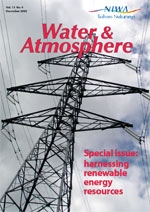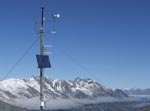


Knock-on effects: instruments measure temperature and snowfall at Rose Ridge in the Southern Alps and low water at Lake Tekapo, May 2003. Winter snowfall helps recharge the lake following spring melt. (Photos: Bob Newland and Ian Halstead)

Jim Renwick explains how New Zealand’s energy needs and supplies depend on climate.
The security of supply of the New Zealand electricity system has been called into question in recent years, with two climate-related energy 'crises' already this decade. Much of the hydro storage variability that affects the dry-year risk is related to climate variability. To manage the changing risks, we need to quantify links between climate variability and our renewable electricity resources.
Three major factors come into play: the El Niño/Southern Oscillation (ENSO) cycle, the Interdecadal Pacific Oscillation (IPO), and long-term climate change influenced by increasing greenhouse gases (see box below). All three affect the westerly wind circulation in our region; this in turn controls rainfall in the Southern Alps and key hydro catchments, influences the national capacity for wind generation, affects the coastal wave climate, and influences ground-level solar radiation. Moreover, all three factors influence temperature and rainfall patterns in many major population centres, strongly affecting domestic demand for electricity. NIWA research is helping understand the basic mechanisms of these influences, and is helping the energy sector understand the implications for renewable energy supply and demand (see box below, 'Renewables and climate change: current research').
Climate variability
Recent low inflows to New Zealand hydroelectricity generating lakes (for example, mid-2001) are actually rather mild, compared to the dry period of the mid-1960s. NIWA research shows that the period 1977-98 was relatively wet on the South Island west coast and in the headwaters of key southern lakes, compared to the preceding 30 years. Such long-term variability in lake inflows and rainfall is related to alternating phases of the IPO, a recently identified large-scale pattern of climate variation that affects the whole Pacific basin. The IPO may be changing phase again, back to the pattern observed before 1977. If this occurs, low inflow periods for South Island lakes will be more frequent (and possibly more severe) over the next 20-30 years than was the case during 1977-98. This would pose a significant risk for the security of electricity supply.
Climate change
In the longer term, climate change may mean stronger winds over New Zealand, more reliable flows into our hydro lakes, and a larger capacity for wind-generated electricity. However, climate change will also introduce big changes in the seasonality of hydro storage, because it will change the accumulation and melt of snow in the Southern Alps. NIWA is working to quantify this effect, to enable the energy sector to better plan for the coming 50 years.
A warmer climate will also change the seasonality of demand for electricity, increasing demand for cooling in summer, but decreasing the need for heating in winter. Changes in water availability may lead to big changes in energy needs for irrigation. NIWA is developing risk-management tools to help the energy industry plan infrastructure development, in the face of changing and variable climate patterns.
What ENSO, the IPO, and climate change mean for New Zealand
The El Niño/La Niña, or ENSO (El Niño-Southern Oscillation), cycle involves an irregular exchange of warm surface waters between the western and eastern Equatorial Pacific. The normally cool region off the coast of South America warms up in an El Niño, associated with a weakening of the trade winds and changes in tropical rainfall patterns. Such tropical shifts have effects all around the Pacific, making for cooler, windier weather over New Zealand during El Niño. A La Niña period sees the eastern Equatorial Pacific cool even more than normal, and the trade winds increase in strength. The net effect on New Zealand is generally warmer, less windy conditions, especially over the summer months.
The Interdecadal Pacific Oscillation (IPO) exerts a long-term influence over the ENSO cycle, bringing 20-30 year periods of strong and frequent El Niño events, or periods of weak El Niño and stronger La Niña conditions. The IPO does this by changing the background conditions in the Pacific Ocean, the canvas upon which ENSO events play out. During the positive IPO (for example, late 1970s to late 1990s), frequent El Niño events are common. In the negative IPO (as in the late 1940s to mid 1970s), La Niña events are more common, and generally mild and less windy conditions prevail over New Zealand.
Climate change, driven by increasing greenhouse gases, is very likely already causing a rise in temperatures around New Zealand, and is expected to slowly change wind and rainfall patterns. The climate system is moving in the direction of stronger westerly winds over New Zealand, more rainfall in western and alpine regions – including key southern hydro catchments – and a warmer climate, especially in the north and in winter. Such trends are likely to continue through at least the next century. They have serious implications for both energy demand and supply, as well as for all other aspects of New Zealand society.
Planning ahead for change
- Our renewable resources are largely controlled by the climate, especially during El Niño and La Niña.
- Operation of the electricity system needs to take account of the seasonal-to-decadal changes.
- Long-term climate change will affect both our energy requirements and the availability of renewable resources.
Renewables and climate change: current research
In collaboration with the Ministry for Economic Development, NIWA has developed scenarios for future national hydro storage for the coming 25 years, based on knowledge of the IPO and climate change trends, helping set the scene for national energy development. NIWA is also developing tools to simulate typical patterns of rainfalls, temperature and river flows, given different combinations of El Niño, the IPO, and climate change. An important component is in quantifying how snow storage in the Southern Alps is likely to change in future. Using these tools, energy companies will be able to optimise their climate-related planning and risk management
Dr Jim Renwick studies climate variability and change and their effects. He is based at NIWA in Wellington.
Teachers’ resource for NCEA AS: Science 90313 (2.2); Geography 90337 (2.7). See other curriculum connections at www.niwa.co.nz/pubs/wa/resources
